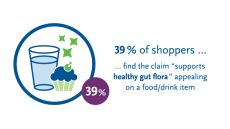Chr. Hansen CEO talks tapping food’s top five mega-trends

Mauricio Graber joined Chr. Hansen as chief executive earlier this year. Coming from flavours and fragrances group Givaudan, where he was president of the flavours division, the business executive has a strong track record in the ingredients sector.
Chr. Hansen was a particularly attractive proposition, Graber explained, because in his view the company’s product portfolio leaves it particularly well positioned to capitalise on some of the most important mega trends shaping the global food and beverage space today.
“One of the things that is quite unique about Chr. Hansen and that really attracted me to join and lead the company is the positioning that it has. It is so aligned with the global megatrends of what the food beverage and health and nutrition industries require,” Graber told FoodNavigator.
According to the company, 82% of its products support the United Nations Sustainable Development Goals. “We are really working towards health, nutrition [and] natural solutions to find better products to feed the growing population,” Graber explained.
Chr. Hansen delivered its full-year results today (15 October). The company reported 9% organic sales growth. Currency exchange weighed on the top line and total sales were up 3% to just under €1.1bn.
Profit for the year rose 2% to €228m and EBIT excluding special items increased 4% on stronger operating margins.
The company raised its organic growth target to 9-11% for the coming financial year.
Mega trend: Global growth of dairy
The first mega-trend that Graber sees Chr. Hansen supporting is the expansion of the dairy category globally.
Chr. Hansen also revealed it acquired Austria-based dairy ingredient supplier Österreichische Laberzeugung Hundsbichler to expand its presence in the specialty cheeses segment today.
Headquartered in Langkampfen, Hundsbichler produces the BioRen brand. Chr. Hansen said the deal will allow it to boost its enzyme production and offer a product portfolio in the animal rennet space that is "second to none". Financial details were not disclosed.
“The category is developed in Western Europe and the US and what we have seen is a tremendous growth and expansion of dairy into China and other parts of Asia, Latin America and increasingly to Eastern Europe [which are] what I would call high growth markets.”
Graber believes that the capabilities Chr. Hansen has in “lactic acid bacteria” are “fundamental” to support the development of these emerging markets for the dairy category. “[The sector] has tremendous growth potential as dairy is increasingly considered a healthy choice of food by consumers in traditional non-dairy markets such as China, where Chr. Hansen has seen strong growth in recent years. Not only are yogurt and fermented milk products gaining strong ground among health-conscious consumers in the region, they are also very open to products that have been enriched with probiotics.”
As global dairy expands and production increases, Chr. Hansen can play a role in improving sustainability in the sector, Graber suggested. “Producing more with less is a constant focus for our innovation team. We help our customers to improve yields and productivity, so that they can get more cheese from a litre of milk, for instance. That is a way for us to make a difference in the sector."
Mega trend: Sustainability and plant-based proteins
Alongside the growth of dairy, Graber also recognises a jump in interest in plant-based alternatives to animal proteins. He does not view this as contradictory and believes that Chr. Hansen is well-placed to develop this area of the market also.
“In anything in the world, you will always find a little bit of the dichotomy,” he observed wryly. “The capabilities that we have in dairy can also support platforms of non-dairy solutions where we use other potential types of proteins, plant-based proteins, to develop products that have a dairy-like taste. When developing plant-based products our capabilities and understanding of dairy play an important role."
The ingredients supplier already offers some alternative protein solutions and its innovation pipeline reflects the company’s ambitions to develop this area further, the chief executive revealed.
“The area is emerging but it's something that we definitely have interest in and resources allocated to so that we can be on trend and leverage our capability and innovation for plant-based protein solutions.”
Mega trend: Food waste and fermentation
Through its bio-protection know-how, Chr. Hansen is positioned to offer solutions to food spoilage while also maintaining a clean label profile. The company’s bio-protection products have been developed as an alternative to chemical preservatives.
“Through bio protection we can use good bacteria to reduce food spoilage and making sure that we are able to reduce food waste starting from our knowledge in dairy, but expanding into many other food categories,” Graber explained.
In yogurt, for instance, data provided by Chr. Hansen claims 17% of yogurt is wasted globally, of which 80% is discarded due to expiry dates. The company’s bio-protective solutions can extend shelf life by seven days and Chr. Hansen has set a goal of reducing global yogurt waste by 1.2 tonnes by 2022 through increased commercial reach of its bioprotective cultures.
“And that's on food. On beverages, we have seen something that I'm very, very, excited about.”
The market has seen “tremendous growth” in the fermented beverage segment – and this represents a significant growth opportunity for Chr. Hansen, he continued.
“I could see us playing a larger role in the future of malted beverages, fermented beverages and solutions for innovation in the beverage category. I'm really excited about that and so is our team is here.”
Mega trend: Health and nutrition
Chr. Hansen’s health and nutrition business is focused on science-based technological solutions and it houses one of the company’s so-called “strategic lighthouses”, the human microbiome (the totality of microbes in and on the human body that can be the source of next generation probiotics).
In health and nutrition, Graber said the company has “three or four key priorities”. In plant health, the group is working on tackling pesticide use in agriculture through microbial solutions, in animal health the company is working to reduce the use of antibiotics in animal farming, and in human health, Graber said, the group has taken “tangible steps” in its probiotics focusing on the “world’s best documented strains”.
The group is further extending its innovation around human health: “As we continue to learn and develop more we see the tremendous potential that good bacteria will have overall for the concept of good health. Our know-how of good bacteria holds the potential not only to play a key role for humans’ health overall, but also for oral health and skin health.”
Mega trend: Natural colours and clean label
The clean label trend is an overarching theme in Chr. Hansen’s portfolio. This can clearly be seen in the group’s natural colours business, which accounts for about 20% of group sales.
The “biggest trend” in colours is the need for natural solutions that perform well, Graber noted.
Describing the unit – a leader in the natural colours space - as a “beautiful business” he revealed that the company is continuing to advance its technology to tackle two issues: parity with synthetic options in terms of cost and performance.
“We need to continue to advance our technology to make natural colours more cost-effective and have a better performance in the desired application…. That's a pretty exciting growth opportunity.
“When you hear us talk about what makes Chr. Hansen unique, it is really the combination of those things. Our purpose is about precisely that: microbial solutions and natural solutions. I quite like that.”
A compelling organic growth story
While Chr. Hansen’s two business units for enzymes and cultures and for health and nutrition share the same microbial platform, R&D in colours has less overlap because it is based on a completely different technology. This has led some to speculate that the company could sell-off colours to focus on its core microbial platform.
Food cultures and enzymes saw organic growth of 12% in the latest financial year; compared to 8% in health and nutrition and 5% in natural colours.
Graber downplays this possibility, insisting that while the research overlap is limited sales synergies strengthen Chr. Hansen’s overall customer proposition.
“They may not have a very strong connection in the research fundamental [but] they have a connection in our go-to-market approach. There are synergies particularly in the dairy and the beverage segments. For our dairy customers we can offer not only cultures and enzymes but also our probiotics, our bio protection, and our natural colours that could ultimately end up in the same product for the consumer. So I most definitely think there are synergies in the go-to-market. We have a company with three very strong businesses.
“We have no plans to divest the colour business; I'm really happy to run it and make it perform to the best of its abilities. Since it was made a stand-alone business in 2015, assuming full responsibility for its own value chain, the division is steadily taking important and significant steps towards realizing its full potential and the long term expectations for the business.”
While the ingredients sector has seen a number of significant deals of late – IFF’s acquisition of Frutarom most recently – Graber is bullish about Chr. Hansen’s organic growth story.
“Chr. Hansen benefits from being a focused organization on our natural and microbial platform solutions. The M&A that you have seen in the ingredients sector, is driven by companies trying to better positions themselves to the megatrends.
“For us, our organic growth strategy is extremely compelling… If we found bolt-on acquisitions that support either our go-to-market, our product offerings, our technologies for those lighthouses, that would be something we would consider. But we definitely have a unique position simply by remaining a focused organization committed to our core.”



























